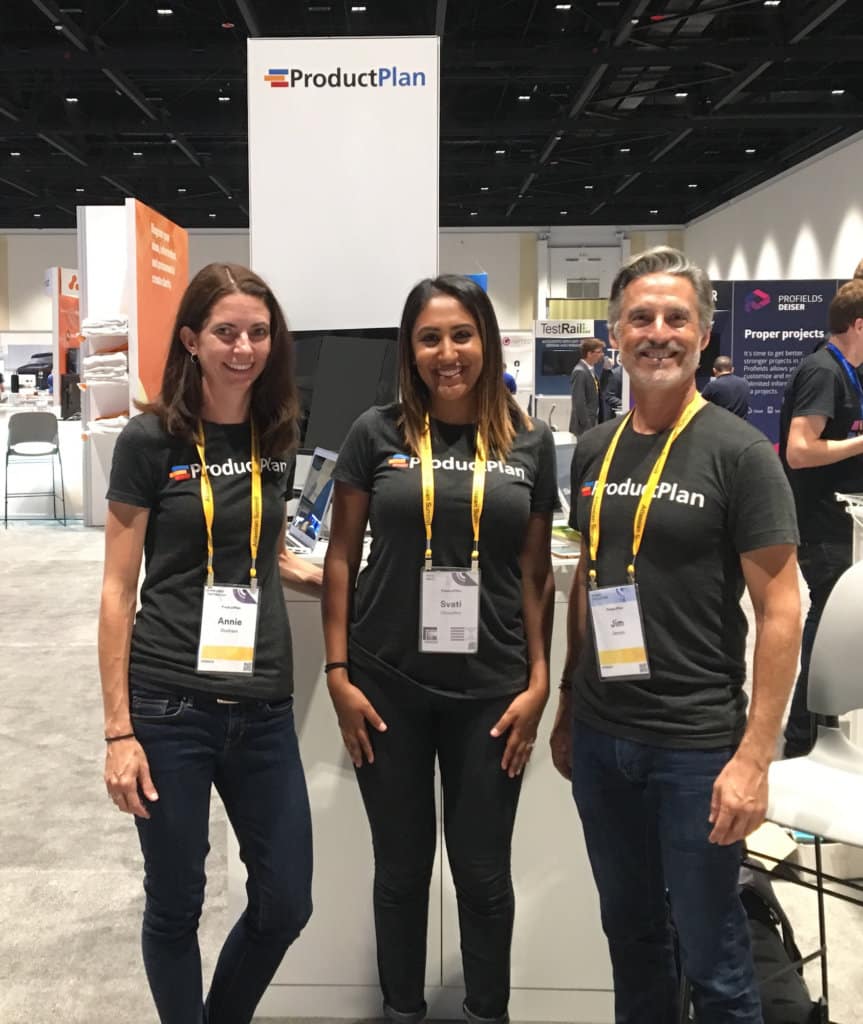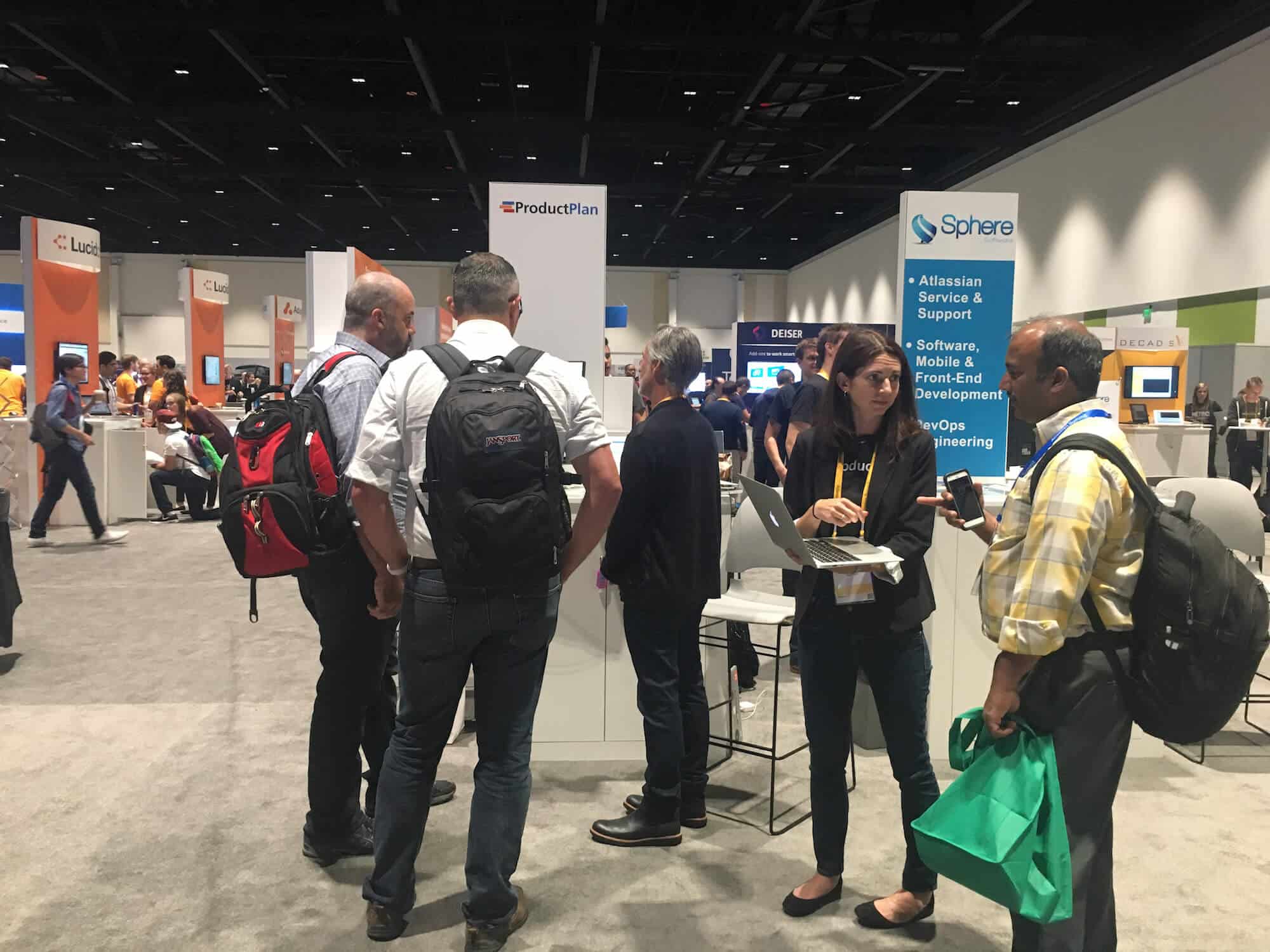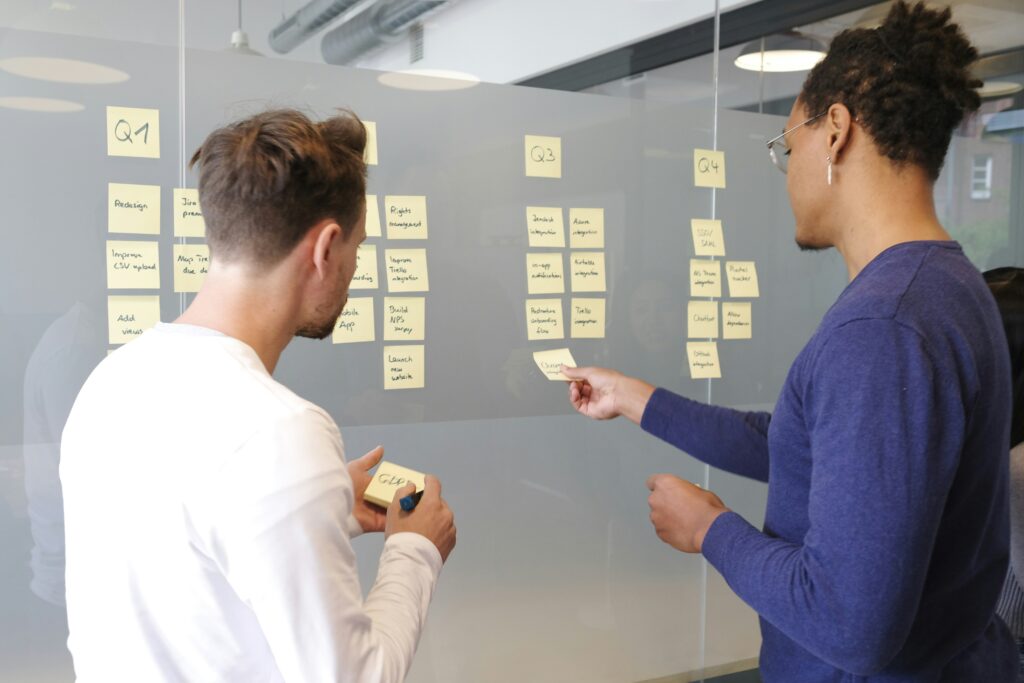This week, more than 3,500 attendees from 50 different countries arrived in San Jose, California for the 2017 Atlassian Summit. Events like these are an excellent opportunity for product managers to interact with reps for popular product-oriented tools like Jira and Confluence, chat with their own customers and prospects, and interact with product folks from other organizations.
ProductPlan sponsored the event and team members were on hand to chat with visitors about roadmapping best practices, attend workshops, and more. It was a great experience and we thought we’d share some highlights from the Summit along with some advice about events in general. Here are eight tips to help product managers make the most of their next event experience:
1. Meet new prospects.
Approach and chat with attendees who aren’t your customers. Figure out their motivations for attending the event, if they’re happy with their existing toolstack, or if they’re looking to solve a specific problem. Are they using one of your competitors? Why? Are they in an adjacent market you might be targeting in the future?
This doesn’t mean every interaction needs to be a sales demo. Think of these chats as mini interviews and think of the event as a fact-finding mission where discovery is the primary goal. Bonus: Schedule meetings or social events with local prospects ahead of the event to ensure you make the most of your travel.
2. Be a customer for a while.
If you’re headed to a large branded trade show like Atlassian Summit, you’re likely to run into representatives from other sponsoring companies. It’s a great opportunity to play the role of customer and offer feedback, discuss upcoming releases, and updates to strategy. We were happy to meet with executives and product managers from Atlassian to discuss our ongoing partnership, shared values, and enhanced integrations with Jira and Confluence. Your day-to-day life as a product manager means you eat, sleep, and breathe your product, but you also use lots of products as a customer and events can be a great opportunity to switch hats and offer feedback to someone else!
3. Meet your customers.
For your existing customers, use the event as a research opportunity to get product feedback, refine your user personas, and give your customers a friendly, human face to associate with your product. Figure out why your customers are attending the event. Why are they here? What are they looking for? Are they evaluating new tools, exploring alternative solutions, or just catching up socially and collecting swag? Their answers will likely vary by segment, industry, role in the company, etc., but events are generally a great way to informally meet your customers and deepen your relationship.
During Atlassian Summit, we met some of our customers who provided a lot of friendly (and useful) feedback on ProductPlan. Starting a conversation at an event means you can easily pick up where you left off when you get back to the office. On that note, it’s great to take notes during the event, both for your own reference and to share with your team after the event. We recommend creating a new chat room where you can quickly share ideas with your team back at the office during the event.
One of the key points Atlassian co-founder and co-CEO Mike Cannon-Brookes made in his product-focused keynote presentation was that “the best way to understand a company’s culture is through its people.” We recently wrote a blog on things a product manager should do in their first 30 days at a new company and one of our recommendations was to figure out where your customers spend their time. The events they attend certainly fall under this recommendation and chatting in person is a great way to understand your customers and their respective company cultures.
4. Be transparent with fellow vendors.
Atlassian emphasized during the Summit that “open work helps teams work better together.” In other words, transparency can lead to efficiency. For vendors, this means networking with other vendors, even, in some cases, your competition. You have something in common with at least some of the other vendors in the room. You probably have some customers in common. They’ve probably tackled similar challenges or opportunities that you’re currently facing, i.e. integrating with the Atlassian suite. Atlassian Summit was a great chance for us to talk to other companies about how and why they integrated with Atlassian products. Candor tends to encourage more candor and if you’re open and transparent with fellow vendors, you’re likely to learn something new.
Part of your job is to understand where the market is heading and why. You can help each other understand differentiators and shared challenges, without feeling like you’re giving away your competitive advantage.
5. Ask questions.
Practice describing and asking questions about your product (at light speed). If you’re spending anytime working your company’s booth, you’re going to get the chance to speak (briefly) with hundreds of people. Events are a great opportunity to hone your product’s elevator pitch, condense its features, benefits, and value proposition, and quickly identify the problem your product solves. These are all things you likely do on a daily basis with various product stakeholders, but you probably don’t do it over and over again in 2-3 minute intervals with hundreds of people in a row. That volume really requires you to cut to the chase and understand the core value of your product.
Beyond describing your product, the booth also provides a great opportunity to conduct quick interviews with customers, prospects, and fellow vendors. You’re competing with hundreds of other colorful booths, flashing demo stations, snack tables, and swag giveaways, and you want to be sure when you get someone’s attention you don’t ask them about the weather.
Events are a fantastic opportunity to sharpen and practice your interviewing skills, distilling your long list of product-related questions into 2-3 core questions that ensure you make the most of your time. If you’re talking to a prospect, you might ask them how they’re currently addressing the problem your product aims to solve. In our case, it might be something like “How are you currently communicating your product strategy to stakeholders?” It’s concise. It’s open-ended. It’s a great starting point for a broader conversation. For existing customers, you can ask them how they’re using your product today, and if there’s something about it you could change or update to make them more successful in their job? However brief their answer might be, this type of face-to-face, direct feedback is typically invaluable.
6. Conduct market research.
Get a sense of the state of the market. Many of the sessions and keynote presentations at Atlassian Summit focused on large trends in the software industry, including a growing focus on the DevOps community, infrastructure-as-code, and issues around scalability. Since Atlassian has more than 90,000 customers worldwide, their view of the marketplace is extremely insightful.
During one of the Atlassian Summit keynotes, Jira team members discussed their belief that technology companies are beginning to move “beyond agile,” shifting more toward continuous development and DevOps practices. While you’re unlikely to make sweeping changes to your product roadmap based on a single keynote address, information like this is important to take note of and investigate. This shift toward DevOps is likely to impact Product Managers that work with development teams, directly impacting how work gets done.
Beyond explicit talks devoted to the state of the industry, there’s often a couple of emergent themes at each event—ideas, companies, or products that everyone seems to be talking about in the exhibition halls or during social events. These whispers can be invaluable for product folks wondering where things might be headed next year.
7. Take advantage of getting outside.
Enjoy being out of the office. Any time you can get out of the office or deviate from your daily work routine is a great time to examine why you have the processes that you do. Summit had a particularly inspirational keynote on this front, highlighting how breaking your regular routine can be very energizing, ultimately reinvigorating your enthusiasm for your product and career. Bonus points if you can pass on some of this energy to your team when you get back to work.

8. Finally, remember to have fun.
People do business with people. You solve problems for people. Take some time to meet other attendees outside of the exhibition hours and head to some of the social events. Grab a drink! Grab some swag! Talking to all those people at the booth is super helpful but can be a bit grueling and event organizers purposefully build in this time to unwind with teammates and new friends for a reason. If you remember to enjoy yourself, you’re much more likely to go home with a fresh perspective on your product.
If you weren’t able to attend the event in person, Atlassian is making videos of some of the top sessions and presentations available here.
Have more tips for product managers on their way to an event like Atlassian Summit? Leave them in the comments below!



